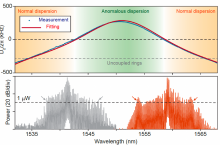
Normal group velocity dispersion (GVD) microcombs offer high comb line power and high pumping efficiency
compared to bright pulse microcombs. The recent demonstration of normal GVD microcombs using CMOS foundry-produced
microresonators is an important step toward scalable production. However, the chromatic dispersion of
CMOS devices is large and impairs the generation of broadband microcombs. Here, we report the development of a
microresonator in which GVD is reduced due to a coupled-ring resonator configuration. Operating in the turnkey
self-injection locking mode, the resonator is integrated in a hybrid manner with a semiconductor laser pump to produce
high-power efficiency combs spanning a bandwidth of 9.9 nm (1.22 THz) centered at 1560 nm, corresponding to 62
comb lines. Fast, linear optical sampling of the comb waveform is used to observe the rich set of near-zero GVD comb
behaviors, including soliton molecules, switching waves (platicons), and their hybrids. Tuning of the 20 GHz repetition
rate by electrical actuation enables servo locking to a microwave reference, which simultaneously stabilizes the comb
repetition rate, offset frequency, and temporal waveform. This integrated hybrid system could be used in coherent communications
or for ultrastable microwave signal generation by two-point optical frequency division.